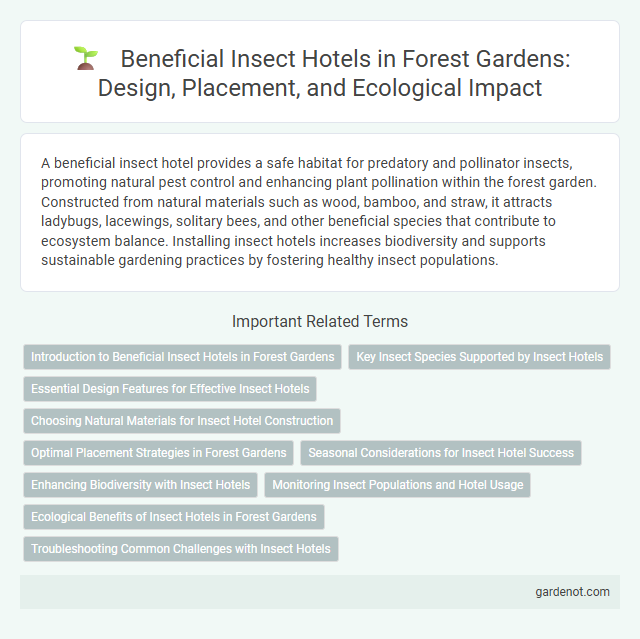A beneficial insect hotel provides a safe habitat for predatory and pollinator insects, promoting natural pest control and enhancing plant pollination within the forest garden. Constructed from natural materials such as wood, bamboo, and straw, it attracts ladybugs, lacewings, solitary bees, and other beneficial species that contribute to ecosystem balance. Installing insect hotels increases biodiversity and supports sustainable gardening practices by fostering healthy insect populations.
Introduction to Beneficial Insect Hotels in Forest Gardens
Beneficial insect hotels serve as essential habitats that attract pollinators and natural pest controllers within forest gardens, enhancing biodiversity and plant health. These structures provide shelter and breeding grounds for species like ladybugs, solitary bees, and lacewings, which contribute to improved pollination and pest management. Strategically placing insect hotels in diverse forest garden layers supports ecological balance and promotes sustainable gardening practices.
Key Insect Species Supported by Insect Hotels
Beneficial insect hotels support key species such as solitary bees, ladybugs, lacewings, and predatory wasps, all crucial for pollination and pest control in forest gardens. Solitary bees, including mason and leafcutter bees, use insect hotels as nesting sites, enhancing fruit and vegetable yields by increasing pollination rates. Predatory insects like ladybugs and lacewings found in insect hotels naturally suppress aphids and other pests, promoting a balanced ecosystem and reducing the need for chemical pesticides.
Essential Design Features for Effective Insect Hotels
Essential design features for effective insect hotels include varied materials such as bamboo tubes, hollow stems, and wood blocks with drilled holes to mimic natural nesting sites. Incorporating multiple cavity sizes and orientations supports diverse beneficial insect species like solitary bees, ladybugs, and lacewings. Protecting the structure from moisture and predators with a sloped roof and placing it in sunny, sheltered locations maximizes insect occupancy and pest control benefits in forest gardens.
Choosing Natural Materials for Insect Hotel Construction
Selecting natural materials such as untreated wood, bamboo, straw, and dried leaves creates an ideal habitat for beneficial insects in a forest garden insect hotel. These materials provide suitable shelter, moisture retention, and temperature regulation, fostering bee pollinators, ladybugs, and lacewings essential for pest control and pollination. Using locally sourced, chemical-free materials supports biodiversity and enhances the ecological balance within the garden ecosystem.
Optimal Placement Strategies in Forest Gardens
Optimal placement of beneficial insect hotels in forest gardens involves situating them near flowering plants, fruit trees, and herb beds to maximize pollinator activity and pest control. Positioning these hotels in sheltered, sunny locations with minimal wind exposure supports insect habitation and breeding success. Incorporating diverse native plant species nearby creates a thriving ecosystem that enhances the effectiveness of beneficial insects in maintaining forest garden health.
Seasonal Considerations for Insect Hotel Success
Insect hotels in forest gardens thrive when tailored to seasonal needs, providing shelter during winter hibernation and breeding habitats in spring. Materials like hollow stems and dry leaves retain moisture and warmth critical for early spring emergence. Proper placement ensures insects access sunlight in colder months and shade during peak summer heat, optimizing survival and pollination efficiency year-round.
Enhancing Biodiversity with Insect Hotels
Insect hotels play a crucial role in enhancing biodiversity within a forest garden by providing safe nesting and overwintering habitats for beneficial insects such as solitary bees, ladybugs, and lacewings. These structures support pollination and natural pest control, leading to increased plant health and productivity. Integrating insect hotels strategically boosts ecosystem balance and promotes a thriving, diverse garden environment.
Monitoring Insect Populations and Hotel Usage
Beneficial insect hotels play a crucial role in forest gardens by providing shelter for pollinators and predatory insects, enhancing biodiversity and natural pest control. Monitoring insect populations and hotel usage helps assess the effectiveness of these habitats, using tools like video surveillance and insect traps to gather data on species diversity and activity patterns. This information guides management practices to optimize the hotel's design and placement, increasing ecological balance and productivity in the forest garden.
Ecological Benefits of Insect Hotels in Forest Gardens
Insect hotels provide essential habitats for pollinators and natural pest controllers, enhancing biodiversity within forest gardens. They support species such as solitary bees, ladybugs, and lacewings, which improve fruit set and reduce harmful insect populations. This ecological balance promotes sustainable plant growth and increases overall garden productivity.
Troubleshooting Common Challenges with Insect Hotels
Troubleshooting common challenges with beneficial insect hotels involves identifying factors like moisture buildup, poor ventilation, and inappropriate materials that deter insect habitation. Ensuring proper placement in sunny, sheltered locations and using a variety of natural materials such as bamboo, hollow stems, and wood with drilled holes can significantly enhance occupancy rates. Regular monitoring and cleaning prevent mold growth and parasite infestations, maintaining a healthy environment for pollinators and pest predators in forest garden ecosystems.
Beneficial insect hotel Infographic

 gardenot.com
gardenot.com